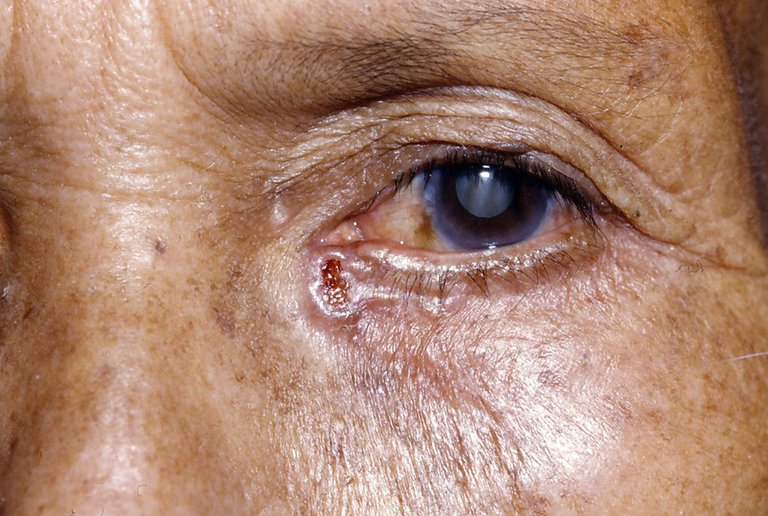Carcinoma Cancer; Encompassing the epithelial tissue.
I was very surprised to read that this cancer type is a common type of cancer, I mean I have heard about other types of cancer that people get to talk about often but not about carcinoma. Interestingly, carcinoma accounts for about 80%-90% of all diagnostic cancer cases.
Carcinoma is a form of cancer that forms in the epithelial tissue. Epithelial tissue is responsible for the lining of most organs in the body, the internal passageways, and the skin. Most of the cancers that affect the skin, kidney, prostrate gland, breasts, head, and neck are all classified as carcinomas. Do you see why it is so common, it is a combination of several organs in the body.

flickr.com
It is common practice for us to only think of cancer classification based on the region affected, for example, the breast and colon types of cancer, but this is just one way of classification, scientists on the other hand, classify cancer types based on the type of tissue where the cancer cells begin to grow. The classification of cancer-based on tissue types includes;
Carcinoma, which is the cancer that begins in the epithelial tissue.
Leukemia, which is a cancer that begins in the bone marrow, the point where blood cells are made.
Sarcoma, this cancer type begins in the connective and supportive tissue.
Myeloma, this cancer begins in plasma cells that are inside the bone marrow.
Mixed type of cancer affects more than one type of tissue.
From the description of carcinoma, we understand it has to be vast, so let's talk about the different existing types of carcinoma.
Basal cell carcinoma: This is the most common form of all cancers, it happens in the cells that line the deepest part of the skin's outer layer.
To avoid getting scars, you also need to get quick treatment, but it is rare for carcinoma to spread to other parts of the body, it usually has an appearance of; pink growths, red patches, shiny bumps or scars, and open sores. There is a high chance of getting carcinoma by spending excessive time in the sun, leading to a few bad sunburns.
Renal cell carcinoma: This is the most common type of kidney cancer, often growing as a single form of tumor within the kidney. Usually discovered with the help of a CT scan or ultrasound, sometimes it is only detected after it has become large or it has spread to other organs of the body.
Adenocarcinoma: This type of carcinoma often begins in the cell called "glandular cells", these glandular cells are found in different organs of the body.
Squamous cell carcinoma: Although famously known for having a strong effect on the skin, it can also be found in other parts of the body like the cell lining; the digestive tract, respiratory tract, and certain organs. When a person is affected with squamous cell carcinoma, it affects regions like the; lips, neck, ears, and face.
Open sores, warts, scaly red patches, and growth with a depression in the middle are signs of squamous cell carcinoma.
Invasive ductal carcinoma: This is a form of breast cancer that begins in the milk duct but spreads to the fatty tissue of the breast. It can also spread to other body parts through the bloodstream and lymph system. Symptoms include; swelling on one breast, thickening of the breast skin, rash or redness of the breast, lumps in the underarm, and dimpling around the nipple or breast skin.
Ductal carcinoma in situ (DCIS): With this condition, cancer cells are found inside the ducts of the breast, with DCIS, the cancer has not developed completely or spread to other areas. Most women with this diagnosis get cured eventually.
Just like all cancer types, carcinoma also begins with a genetic mutation, then it transforms a normal and healthy cell into a cancerous one. The cancer cell continues to multiply and create more cancer cells, when left untreated for a long time, the cancer cells could invade nearby healthy tissues. After some time, the cancer cells could travel through the bloodstream or lymphatic system to invade other parts of the body.
Different demographic factors will influence the chances of developing carcinoma;
Sex: Aside from the fact that carcinomas affect the breast, the risk of carcinoma is high amongst those assigned at birth.
Age: The risk of carcinoma increases after the age of 65, it is very rare in children.
Ethnicity/race: Black race stands a higher chance of developing carcinoma, like cancer of the lung, colon, and prostate.
To carry out a proper diagnosis, a proper medical review will be carried out, the doctor will ask about the symptoms felt and then recommend any of the following tests if carcinoma is suspected.
Physical examination requires medical examination of the skin changes that may indicate the presence of squamous cell carcinoma or basal cell carcinoma. Breast examination gives room for the medical expert to detect abnormal growth or symptoms that may be a sign of ductal carcinoma, such as nipple discharge or skin changes.
Blood tests will help detect the level of protein, enzyme, tumor markers, and other forms of indicators that could lead to getting an appropriate diagnosis.
A biopsy is the only way to confirm the presence of carcinoma. Punch biopsy, core needle biopsy, surgical lymph node biopsy, shave biopsy, and others. Although the procedures for the biopsies are different, they all include the medical expert taking out tissues that will later be tested in the laboratory for the detection of cancerous cells.
There are five (5) stages of carcinoma cancer;
Stage 0, at this point the cancer has not spread before the point where it was formed. Stage 0 cancer is in situ, and it is usually curable with the presence of prompt treatment.
Stage 1 of the cancer has a tumor more pronounced than stage 0. At this point, the cancer has not yet spread to nearby organs, tissues, or lymph nodes.
Stage 2 of the cancer means the tumor is bigger than stage 1, and may not have spread to the lymph nodes.
Stage 3 means the tumor is larger now and has spread to other closeby tissues or lymph nodes.
At stage 4, the cancer has become metastatic, which means it has spread to other organs of the body.
Treating carcinoma depends on different factors, including the stage of the tumor, overall health, age, and details of the biopsy. The doctor will share plans with you that will match your situation. Surgery, radiation therapy, chemotherapy, immunotherapy, targeted therapy, and hormone therapy are the available options.
Certain lifestyle behaviors will reduce your chances of getting carcinoma cancer;
You have to limit the intake of alcohol.
Maintain a positive body weight.
Avoid the use of tobacco products.
Use sunscreens and avoid tanning beds.
For Further Studies.
https://www.webmd.com/cancer/what-is-carcinoma
https://www.medicalnewstoday.com/articles/types-of-carcinoma#types
https://www.mayoclinic.org/diseases-conditions/squamous-cell-carcinoma/symptoms-causes/syc-20352480
https://my.clevelandclinic.org/health/diseases/23180-carcinoma
https://training.seer.cancer.gov/disease/categories/classification.html

Hi, I am Tobi a writer, speaker, relationship blogger, and lover of good music. I love making friends and learning from people. If you want to hear me speak on relationships and general life issues, you can find my YouTube channel where you can watch any episode for free, please do not forget to subscribe, friends. I sincerely appreciate every love I get from here, Kindly do well to keep them coming.
Very nice post with very correct detailing however there are different ways of staging and it doesn't necessarily have to be bigger in size before it can be classified as stage 2.
The method of staging you have used is called TNM staging. In TNM staging, when you have a lymph node involved, irrespective of the size it qualifies for stage 3
Also, I feel the factors that lead to cancer cannot be generalized ... As there are some carcinomas that affect children more than adults and also some sex than the other.
What do you think ?
I have never seen carcinoma been discussed this way tho as regards classifying invasive ductal carcinoma and also squamous cell carcinoma..
This was a really educative post and I think your classification is another stand of things.
Appreciate the elaboration buddy, thanks for your time. Have a great week.
Thanks for your contribution to the STEMsocial community. Feel free to join us on discord to get to know the rest of us!
Please consider delegating to the @stemsocial account (85% of the curation rewards are returned).
Thanks for including @stemsocial as a beneficiary, which gives you stronger support.